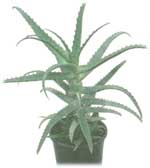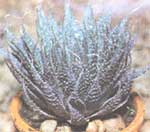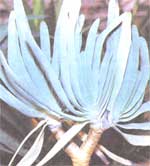Aloe (Stoletnik) / Aloe
Refers to the family of the lily. Fatherland - the tropics of Africa, the Arabian Peninsula and the island of Madagascar.
General description : An impressive variety of species and forms, the most common:
Aloe arborescens (Tree Aloe) is the most popular in our country. He is valued not so much for beauty, as for effective medicinal properties. Thorny, fleshy and narrow leaves, up to 20 cm long, are located on a high stem (up to 1 m). Aloe dendritic possesses numerous lateral shoots.
Rapidly grows, but in ordinary room conditions it blooms very rarely.
Aloe variegata (motley). The leaves of this aloe have a very unusual coloring - dark green (sometimes with a purple tint), with white cross strips and one more thin strip stretches along the edges. The plant is small in size.
Aloe ferox (Aloe vera) is so named because of the reddish thorns resembling warts located on the surface of impressive, fleshy leaves. Very beautiful blossoms with red spicate inflorescences.
Aloe aristata (Asteroid aloe) are often confused with Haworthia. Its leaves, about 10 cm long, just like it does, form a radical rosette from which multiple offspring depart. At the edges of the leaves a white border of teeth, on the surface of translucent warty upbringing. Usually blooms in the warm season.
Aloe humilis (aloe squat) is similar to the previous species. It is distinguished by the blue-green color of the leaves with snow-white denticles.
Recommendations for the care of the plant Aloe:
Illumination: Photophilous, prefer southern windows, but in the spring should be carefully accustomed to direct sunlight, in order to avoid burns.
Irrigation mode: Moderate, by the measure of drying of the soil. In the winter, outlandish.
Humidity of the atmosphere: You can not spray or sprinkle it occasionally and very carefully. Water does not need to please the sinuses of leaflets.
Temperature regime: In summer the temperature should be moderate, in winter it is cool. For the summer it is better to place on a fresh atmosphere (in the park or on the balcony).
Soil: Drainage is mandatory. You can add charcoal and brick chips.
Recommended soil mix: 2 elements of clay-sod land, 1 share of leaf land, 1 share of humus and 1 share of sand.
During the growth period, it needs fertilizing once every two weeks with fertilizers for cacti and succulents.
Breeding: It is easily produced by cuttings. The cuttings are dried for a few days before planting. You can breed like sheets, seeds and layers.
Transplantation: In the spring, young plants annually, mature once a couple of years.
Often, the old aloe dumps the lower leaves and becomes ugly. In this case it is allowed to cut off the bare portion of the stem and re-root the plant.
Pests: It is infrequent.




Aloe arborescens aloe
Distressing Aloe Aloe ferox
Aloe variegated Aloe variegata
Aloe aristata


Comments
When commenting on, remember that the content and tone of your message can hurt the feelings of real people, show respect and tolerance to your interlocutors even if you do not share their opinion, your behavior in the conditions of freedom of expression and anonymity provided by the Internet, changes Not only virtual, but also the real world. All comments are hidden from the index, spam is controlled.